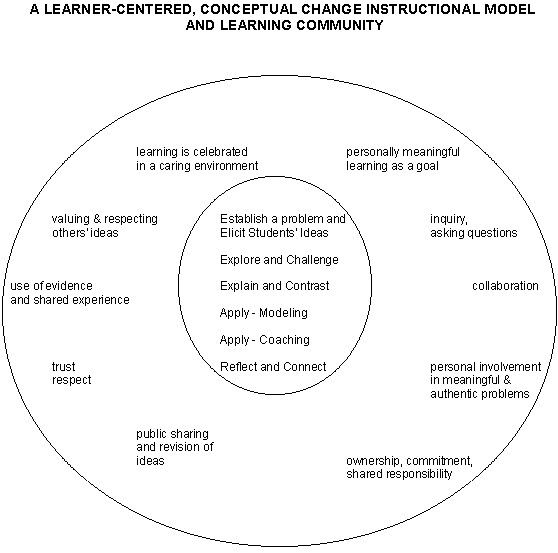Teaching Model
A LEARNER-CENTERED, CONCEPTUAL CHANGE INSTRUCTIONAL MODEL
1. Engage students' interest in a central question or problem and elicit students’ ideas. 2. Explore phenomena to challenge students’ initial ideas. 3. Introduce new ideas and contrast them with students’ initial ideas. 4. Apply - students use the new ideas on multiple occasions, working to reconcile old and new ideas
5. Reflect and Connect - students' reflect on their learning and changes in their ideas and connect with ideas studied during the unit and earlier |
1. Establish a problem and elicit students’ ideas.
Introduce the central question in a way that will engage students’ interest and elicit their many different ideas about the question. Students should see that other students have different ways of explaining the same phenomenon.
2. Explore phenomena and challenge students’ ideas.
Engage students in experience with phenomena (direct, hands-on experience whenever possible) that allows them a chance to think through their ideas, to gather new evidence relevant to the central question, and to consider whether their initial ideas still really make sense in light of the evidence. Activities are designed to challenge students’ preconceptions -- to get them finding their initial ideas incomplete or unsatisfying in some way.
3. Introduce new ideas and contrast them with students’ ideas.
New ideas and concepts are not explained to students until their explorations have convinced them of a need for a new explanation. New concepts need to introduced in ways that are likely to make sense from the students’ perspectives. Use a variety of representations to explain new ideas (models, role playing, charts, diagrams, etc.). Compare and contrast students’ ideas with scientific explanations. Encourage students to critique the new explanation: Does it make sense in light of the evidence we have gathered?
4. Apply new ideas and reconcile them with students’ ideas -- Teacher Modeling
Students need opportunities to practice using new concepts to explain real world situations. The teacher at first plays an important role as director in this process, at first providing lots of modeling of scientific ways of thinking. For example, after students have attempted an explanation of a problem situation, the teacher might point out aspects of their attempts that are scientifically strong and say, "these are the ways scientists would use this concept to think about this situation."
5. Apply new ideas and reconcile them with students’ ideas -- Teacher Coaching
Students need numerous opportunities to practice using new concepts to explain real world situations. Teacher modeling in one context is not enough. A variety of activities and questions that engage students in using scientific concepts and in refining their understanding of these concepts will help students see the wide usefulness of the concepts. During these activities, the teacher should actively coach students, providing them with feedback about ways in which their thinking is strong and ways in which they need to be more scientific in their thinking.
6. Apply new ideas and reconcile them with students’ ideas -- Teacher Fading
Understanding is not occurring until students are able to use new ideas to explain novel situations independently. So it is essential that the teacher coaching fade out as students become more comfortable with working with the ideas.
7. Reflect on changes in students’ ideas and Connect with new ideas.
Students need to reflect often on the ways in which their ideas are changing and why. Frequently, the teacher asks: "How did today’s activities give you any new ideas about our question? Did you change any of your ideas today? What evidence convinced you to do so? What is confusing to you today? What do we still need to know to help us answer our question?" As students reflect their understanding by becoming comfortable using new concepts without teacher coaching, it is especially important to take time to have students look back at the progress of their thinking and learning. Their awareness of their own conceptual change plays an important role in their valuing of the scientific process.

INSIDE CIRCLE: The Instructional Model
OUTSIDE CIRCLE: Characteristics of the Learning Community